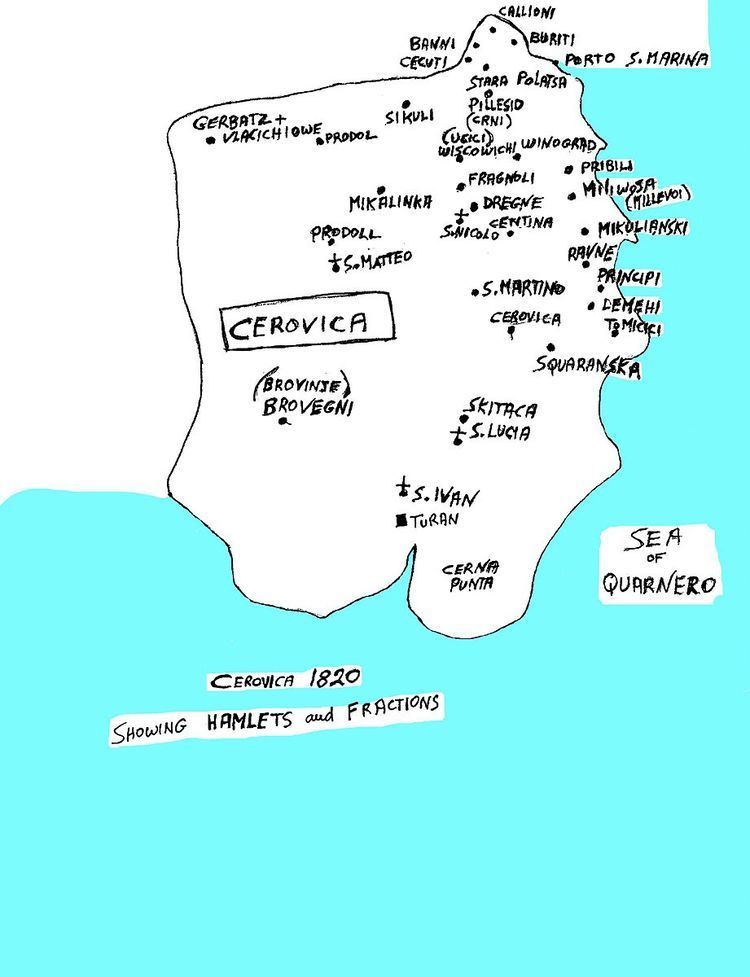Country Croatia Municipality Cerovica (Istria) | County Istria Local time Wednesday 11:39 AM | |
 | ||
Weather 14°C, Wind NE at 19 km/h, 25% Humidity | ||
Note on the Cerovica (Istria) hand drawing
http://www.catasti.archiviodistatotrieste.it/Divenire/ua.htm?idUa=10652011# This is the first map of a series of 19 maps broken down to magnify each part. The map I drew is the simple picture of the total of 20 maps showing where each settlement is located. Anyone can view this on the website, and click on the number on the right, to find information of where a habitable settlement is located in the Commune of Cerovica (Istria). This is the reason I drew the map.
Contents
- Note on the Cerovica Istria hand drawing
- Cerovica Istria in the 1800
- Hamlets in Cerovica in the 1800
- References
From antique times, Albona / Labin, and Fianona / Plomin were two Castles and were considered one District. In 1632 the Administrator of Dalmatia and Albania, Antonio Civran, divided the territory of Albona, L'Albonese / Croatian: Labinština into 12 fractions. The names of these fractions were, Albona/Labin, Rippenda, S.Domenica/S.Nedeglia, Dubrova, Chermenizza, Vlahovo/Vlakovo, Cerovizza/Cerovica, Vettua, Cere, Cugn, Bergod. During the Austrian redivision in 1814-1818 there made two Agricultural municipalities. One was Fianona/Plomin, which consisted of Cerre, Cugn, S.Domenica/S.Nedeglia, Dubrova, Ripenda, Vettua. The other was Albona/Labin, with the fractions of Chermenizza, Bergod, Vlahovo, Cerovizza.
Cerovica (Istria) in the 1800
Cerovica (Istria) was one of twelve Municipalities or Townships in the Labinština peninsula in Istria County, Croatia, during the Austria-Hungary Empire. Cerovica is also the name of a small hamlet north of Skitača in the former municipality of Cerovica (Istria). Also called "St.Lucia di Albona", Skitača. The Municipality of Cerovica (Istria) is located in the southern part of the District of Albona, (Istrian Circle). It is made up of eight various hills some of which are cultivable land. Most of the land was stony and very tough for the settlers when they clear it. The settlers lived in small group of houses called hamlets Croatian: selo or Italian: villa. Cerovica (Istria) borders with the Adriatic Sea at the east and south coast. On the north is the municipality of Chermanizza (Istria). On the south west is the municipality of Vlahovo (Istria). There were no roads until the 1930-40 in the municipality of Cerovica (Istria). Only small paths (called Croatian: stasica which people and animals used to go to various places. The Cement factory in Koromačno built the road in the 1930-40 which is used today to go to Labin and other cities. In 1820 there were 405 people living in municipality of Cerovica (Istria). The people owned 107 oxen, 69 cows, 1098 sheep.In 1824 there were 86 houses most of which were made of dry stone walls and straw roofs. Few of the houses had roofs made with tiles.
Hamlets in Cerovica in the 1800
During the Austria-Hungary occupation and re-organisation the settlements which belonged to Cerovica with Skitača as the head.
